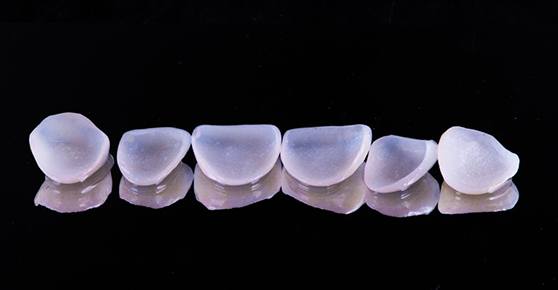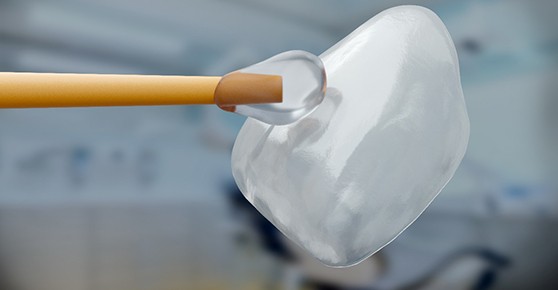Veneers – Burbank, CA
Revamp Your Smile with Veneers
Often enough, patients only have one smile flaw they need to address. It could be some staining, a few minor chips, etc. If you have several flaws at once, though, you might feel unsure about how to proceed. Well, you should try veneers in that case! Dr. Ruiz and his team use these shells to fix many dental imperfections. To learn more about their features and details, keep reading or book a visit soon!
What are Dental Veneers?

Put simply, veneers are thin, tooth-sized shells made of porcelain or ceramic. When placed on the fronts of teeth, they hide a wide variety of smile flaws – chips, cracks, fractures, and more. Their ability to cover misaligned teeth even earned them the nickname “instant orthodontics.”
Of course, veneers do more than just hide things from view. Their high-quality material is customized to match your enamel. As a result, they seamlessly blend with surrounding teeth in color, size, and shape. These effects can last a while, too, thanks to veneers’ high stain resistance and durability. It’s thus no surprise that the shells represent one of cosmetic dentistry’s most popular options.
The Process of Getting Veneers

In general, getting veneers takes two dental visits. The first is a consultation that (if you qualify) includes some prep work. The second is the final placement that sets the prosthetics on your teeth.
As you might expect, the consultation is an in-person meeting with Dr. Ruiz. It usually involves a discussion of your smile goals, medical history, and oral health. This talk then helps our team see if veneers could work for you. Should the answer be “yes,” they’ll draft a custom treatment plan for your teeth.
With dentist approval, a consultation also preps teeth for veneers. This step has Dr. Ruiz clean your pearly whites and remove bits of their enamel. From there, he’ll take a dental impression that a lab uses to make the final prosthetics. That latter process takes a while, so you’ll wear temporary veneers in the interim.
The final placement occurs a few weeks after the consultation. At that time, Dr. Ruiz will fit the shells onto your teeth. You’ll then be ready to enjoy your new smile!
The Benefits of Veneers

With your new veneers, you’ll enjoy a wide variety of benefits. Among them are the following:
- Beautiful, Lifelike Smile: As stated before, veneers are made of high-grade ceramic or porcelain. That fact means they’ll give you a beautiful, lifelike smile. In fact, most people won’t be able to tell it apart from a wholly natural one!
- Versatile Treatment: Veneers cover up the whole front surface of the treated teeth. As such, they can hide various smile flaws at once, including chips, cracks, stains, and dental misalignments.
- Durable Material: Because they’re stain-resistant, veneers don’t discolor as easily as enamel. Therefore, they can better resist stain agents in foods and drinks.
- Long-Lasting Results: On average, a veneer lasts about 15 years. Well-maintained ones, though, can have a lifespan of 30 years or more!
Understanding the Cost of Veneers

Every veneer case that Dr. Ruiz does is custom-tailored to meet his patient’s unique smile goals, which means the cost of veneers can vary. The price tag associated with your treatment will be based on how many restorations you require to achieve a more aligned, brighter, and complete smile, which we’ll help you determine during your initial consultation. Before you decide to move forward with your procedure, we’ll give you a detailed cost estimate and walk you through your payment options so you know exactly what to expect moving forward.
The Value in Choosing an All-Inclusive Treatment

If you suffer from several different types of cosmetic imperfections, like stained teeth, dental damage, and slight misalignment, veneers in Burbank may be an incredibly cost-effective way to refresh your grin without needing to invest your time and money into several different treatments. Our team will examine your mouth and help you determine which of the following cosmetic procedures can also help you achieve your dream grin:
- Invisalign: Invisalign clear aligners are able to treat mild to moderate crowding, misalignment, and bite problems to provide you with a straighter and more functional smile.
- Dental Bonding: Dental bonding is a minimally invasive way to repair mild dental damage, fill gaps between teeth, and even address staining.
- Teeth Whitening: Dental staining can be tackled with either in-office or take-home teeth whitening treatment to help boost your confidence and brighten your smile by up to eight shades.
- Veneers: Veneers are able to improve the appearance of smiles suffering from several different types of flaws with a single procedure. This treatment is also flexible in the fact that it can restore one, several, or all teeth, based on your unique needs.
Although some patients may find that the more cost-effective route to take is teeth whitening or dental bonding if their top concerns are discoloration or dental damage, those who have several priorities may find that veneers are the best choice to meet all of their needs.
Making Veneers More Affordable

Dental veneers are considered a cosmetic treatment, so it’s rarely if ever the case that dental insurance will cover the cost of your treatment. However, our team does work with CareCredit, which is a trusted, third-party financer that offers patients the ability to split the cost of their procedure into smaller, more manageable monthly payments at little-to-no interest. All you need to do is submit an application to find out if you qualify.
Veneers FAQs
Are Veneers Permanent?
Veneers are bonded to the front surface of your teeth and are not meant to be regularly removed and reinserted. That said, they’re not entirely permanent. Although they’re incredibly durable and can last 15+ years, you may have to replace them eventually if they become damaged or worn down.
Keep in mind, Dr. Ruiz will need to remove a thin layer of enamel for your veneers to line up evenly with your natural teeth. Because this protective outer layer doesn’t grow back, this change is irreversible. That means you’ll need to have veneers (or some type of restoration) in place continuously to shield the underlying tooth from potential injury.
Is There Anything I Can’t Eat with Veneers?
Your permanent veneers are somewhat resistant to chipping and staining, but they’re not entirely impervious to harm. Furthermore, you’ll be fitted with temporary veneers while you wait for your permanent ones to arrive to protect your teeth. These aren’t intended for long-term use and are more fragile. To keep them intact, avoid eating hard foods like raw fruits and veggies, candy, or ice. Also, avoid anything overly sticky that can dislodge them.
When your permanent veneers are placed, you’ll still want to steer clear of overly hard or crunchy foods that could damage them. Also, drinking dark beverages like soda, coffee, and tea can stain them over time. Indulging in alcoholic drinks can weaken the bonding material that holds them in place, so try to limit your consumption.
Is It Painful to Get Veneers?
Typically, Dr. Ruiz uses an anesthetic to numb the area before placing veneers so you shouldn’t feel any pain. You may notice some soreness in your gums and jaw after your appointment, especially if you have had several veneers placed. This is normal and usually passes within a week or two.
Some patients experience “bonding sensitivity” which refers to a sharp twinge you feel when biting into something hot or cold. This temporary affliction can be managed by rinsing your mouth gently with salt water to reduce any inflammation. It’s also usually safe to use over-the-counter medications like Tylenol or ibuprofen.
Is There Anyone Who Shouldn’t Get Veneers?
It’s normal to wonder whether you’re a good candidate for veneers. Generally, anyone who wants to improve one or more aspects of their smile is a potential candidate. There are some conditions, however, that could impact your results and need to be addressed, first. They are:
- If you have tooth decay and veneers are placed over it, the problem will only progress over time. By repairing the damage first, we can avoid having to remove your veneers to fix it later.
- Gum disease. Swollen or bleeding gums triggered by this condition can lead to errors in the impressions taken of your teeth and your veneers won’t fit properly as a result. Plus, if your gums recede then you’ll be able to see the margins between your veneers and your natural teeth.
- Bruxism (teeth grinding). People with this disorder subconsciously clench their teeth together at night while they’re asleep. The added force on their teeth and veneers can compromise their bond and cause them to sustain damage or fall off.
If you have additional questions or would like more information, you’re welcome to contact us and we’d be more than happy to assist you!




